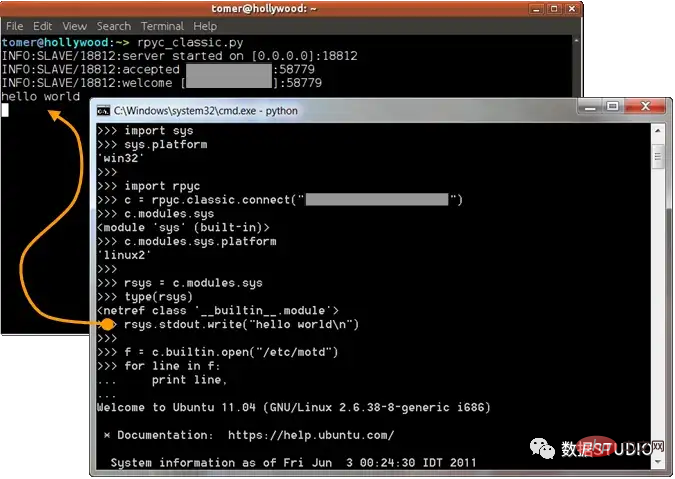又双叒叕 get 了 七个超强的 Python 库
- 王林转载
- 2023-04-11 22:10:101863浏览
有一句谚语:"不必重新造轮子"。Python库是这方面的最好例子。它可以帮助你以一种简单的方式编写复杂而耗时的功能。据我所知,一个好的项目会使用一些最好的库。
1. PySnooper
我们正在编写一个通过返回位列表将数字转换为二进制的函数。@pysnooper.snoop()可以通过添加装饰器来研究它:
import pysnooper @pysnooper.snoop() def number_to_bits(number): if number: bits = [] while number: number, remainder = divmod(number, 2) bits.insert(0, remainder) return bits else: return [0] number_to_bits(6)
或者,如果不想跟踪整个函数,则可以将相关部分包装在一个with块中:
import pysnooper import random def foo(): lst = [] for i in range(10): lst.append(random.randrange(1, 1000)) with pysnooper.snoop(): lower = min(lst) upper = max(lst) mid = (lower + upper) / 2 print(lower, mid, upper) foo()
输出如下:
New var:....... i = 9 New var:....... lst = [681, 267, 74, 832, 284, 678, ...] 09:37:35.881721 line10 lower = min(lst) New var:....... lower = 74 09:37:35.882137 line11 upper = max(lst) New var:....... upper = 832 09:37:35.882304 line12 mid = (lower + upper) / 2 74 453.0 832 New var:....... mid = 453.0 09:37:35.882486 line13 print(lower, mid, upper) Elapsed time: 00:00:00.000344
作为开发者,大部分时间都用在了调试上。这个库是一个调试器。大多数人都会在战略位置上使用print行,其中一些行会显示变量的值。这个库可以做同样的事情,只不过你不需要精心设计正确的print行,而只需要在你感兴趣的函数上添加一行装饰符。你会得到一个函数的逐字记录日志,包括哪些行在什么时候运行,以及局部变量什么时候被改变。它在GitHub上有超过15k颗星。
项目地址:https://github.com/cool-RR/PySnooper
2. schedule
人类的 Python 作业调度。使用友好的语法定期运行 Python 函数(或任何其他可调用函数)。
- 一个简单易用的 API,用于安排作业,专为人类设计。
- 周期性作业的进程内调度程序。不需要额外的过程!
- 非常轻巧,没有外部依赖。
- 出色的测试覆盖率。
- 可在 Python 和 3.6、3.7、3.8、3.9 上测试
import schedule
import time
def job():
print("I'm working...")
schedule.every(10).seconds.do(job)
schedule.every(10).minutes.do(job)
schedule.every().hour.do(job)
schedule.every().day.at("10:30").do(job)
schedule.every(5).to(10).minutes.do(job)
schedule.every().monday.do(job)
schedule.every().wednesday.at("13:15").do(job)
schedule.every().day.at("12:42", "Europe/Amsterdam").do(job)
schedule.every().minute.at(":17").do(job)
def job_with_argument(name):
print(f"I am {name}")
schedule.every(10).seconds.do(job_with_argument, name="Peter")
while True:
schedule.run_pending()
time.sleep(1)这是一个面向人类的Python作业调度库。它可以让你使用友好的语法周期性地运行Python函数(或任何其他可调用)。它包括很多功能,比如周期性工作的进程内调度器(不需要额外的进程),非常轻量级,没有外部依赖性,有很好的测试覆盖率等等。这个库在GitHub上有超过10k颗星。
项目地址:https://github.com/dbader/schedule
3. MechanicalSoup
"""Example usage of MechanicalSoup to get the results from the Qwant
search engine.
"""
import re
import mechanicalsoup
import html
import urllib.parse
# Connect to Qwant
browser = mechanicalsoup.StatefulBrowser(user_agent='MechanicalSoup')
browser.open("https://lite.qwant.com/")
# Fill-in the search form
browser.select_form('#search-form')
browser["q"] = "MechanicalSoup"
browser.submit_selected()
# Display the results
for link in browser.page.select('.result a'):
# Qwant shows redirection links, not the actual URL, so extract
# the actual URL from the redirect link:
href = link.attrs['href']
m = re.match(r"^/redirect/[^/]*/(.*)$", href)
if m:
href = urllib.parse.unquote(m.group(1))
print(link.text, '->', href)这个库将帮助你实现与网站的自动互动。它自动存储和发送cookies,跟踪重定向,并能跟踪链接和提交表单。它不做Javascript。这个库在GitHub上有超过4k颗星。
项目地址:https://github.com/MechanicalSoup/MechanicalSoup
4. ftfy
>>> from ftfy import fix_encoding
>>> print(fix_encoding("(ง'⌣')ง"))
(ง'⌣')ง它能做什么
以下是 ftfy 可以做什么的一些示例(在现实世界中找到):
ftfy 可以通过检测明显是 UTF-8 但被解码为其他字符的字符模式来修复 mojibake(编码混淆):
>>> import ftfy
>>> ftfy.fix_text('✔ No problems')
'✔ No problems'这听起来不可能吗?真的不是。UTF-8 是一种设计良好的编码,当它被误用时会很明显,而且一串 mojibake 通常包含我们恢复原始字符串所需的所有信息。
ftfy 可以同时修复多层 mojibake:
>>> ftfy.fix_text('The Mona Lisa doesn’t have eyebrows.')
"The Mona Lisa doesn't have eyebrows."它可以修复上面应用了“卷曲引号”的 mojibake,在引号展开之前无法持续解码:
>>> ftfy.fix_text("l’humanité")
"l'humanité"ftfy 可以修复包含字符 U A0(不间断空格)的 mojibake,但 U A0 变成了 ASCII 空格,然后与另一个以下空格组合:
>>> ftfy.fix_text('Ãxa0 perturber la réflexion')
'à perturber la réflexion'
>>> ftfy.fix_text('à perturber la réflexion')
'à perturber la réflexion'ftfy 还可以解码出现在 HTML 之外的 HTML 实体,即使在实体大写不正确的情况下也是如此:
>>> # by the HTML 5 standard, only 'PÉREZ' is acceptable
>>> ftfy.fix_text('PÉREZ')
'PÉREZ'这些修复并不适用于所有情况,因为 ftfy 有一个坚定的目标,即避免误报——它永远不应该将正确解码的文本更改为其他内容。
以下文本可以在 Windows-1252 中编码并在 UTF-8 中解码,并将解码为“MARQUɅ”。然原文已明理,故不改。
>>> ftfy.fix_text('IL Y MARQUÉ…')
'IL Y MARQUÉ…'这个库将帮助你修复以各种方式损坏的Unicode。这个库的目标是接收坏的Unicode并输出好的Unicode,以便在你的Unicode感知代码中使用。它在GitHub上有超过3千颗星。
项目地址:https://github.com/rspeer/python-ftfy
5. rpyc

这是一个透明的python库,用于对称的远程过程调用、集群和分布式计算。它利用对象代理这一技术,利用python的动态特性,克服进程和计算机之间的物理界限,使远程对象可以像本地一样被操作。这个库在GitHub上有超过1k颗星。
项目地址:https://github.com/tomerfiliba-org/rpyc
6. pyglet
pyglet 的一些特性是:
- 没有外部依赖项或安装要求。对于大多数应用程序和游戏需求,pyglet 除了 Python 之外不需要其他任何东西,简化了分发和安装。使用 PyInstaller 等冷冻机可以轻松打包您的项目。
- 利用多窗口和多显示器桌面。pyglet允许你使用多个平台原生窗口,并且完全了解用于全屏游戏的多显示器设置。
- 加载几乎任何格式的图像、声音、音乐和视频。pyglet可以选择使用 FFmpeg 播放音频格式,如 MP3、OGG/Vorbis 和 WMA,以及视频格式,如 MPEG2、H.264、H.265、WMV 和 Xvid。如果没有 FFmpeg,pyglet包含对 wav、png、bmp 等标准格式的内置支持。
- pyglet 完全用纯 Python 编写,并利用ctypes模块与系统库进行交互。你可以修改代码库或做出贡献,而无需任何第二语言编译步骤或编译器设置。尽管是纯 Python,但pyglet具有出色的性能,这要归功于用于绘制数千个对象的高级批处理。
- pyglet 是在 BSD 开源许可证下提供的,允许你将它用于商业和其他开源项目,几乎没有限制。
import pyglet
window = pyglet.window.Window()
label = pyglet.text.Label('Hello, world!',
font_size=36,
x=window.width // 2,
y=window.height // 2,
anchor_x='center',
anchor_y='center')
@window.event
def on_draw():
window.clear()
label.draw()
pyglet.app.run()这是一个跨平台的Python窗口和多媒体库,用于开发游戏和其他视觉效果丰富的应用程序。它支持窗口化、用户界面事件处理、操纵杆、OpenGL图形、加载图像和视频,以及播放声音和音乐。它可以在Windows、OS X和Linux上运行。它在GitHub上有超过1千颗星。
项目地址:https://github.com/pyglet/pyglet
7. rope
import rope.base.project
myproject = rope.base.project.Project('/path/to/myproject')这个库提供了强大而安全的重构。它包括轻度依赖性等特点,与PyRight或PyLance不同,它不依赖Node.js,完全由python编写,等等。它在GitHub上有超过1千颗星。
项目地址:https://github.com/python-rope/rope
文档地址:https://rope.readthedocs.io/en/latest/overview.html
以上是又双叒叕 get 了 七个超强的 Python 库的详细内容。更多信息请关注PHP中文网其他相关文章!

